10 Unique Rare Error Coins
Posted onOffering a unique opportunity to diversify and enrich their numismatic collections, error coins are particularly appealing for collectors. Indeed, boasting intriguing backstories, they add depth and significance to any coin collection. This piece will explore rare coin errors and the history behind them, focusing on:
- Iconic US coin anomalies.
- Famous international error coins.
- Where to source unique error coins.
Watch this informative video to learn more about different types of coin errors:
Rare US error coins
Error coins, esteemed anomalies within the realm of numismatics, offer a glimpse into the intricacies and variations of the minting process. Each of the following rare US error coins showcases unique and intriguing types of errors, ranging from missing mint marks to striking anomalies.
1. The 1943 Copper Penny, with its incorrect planchet composition, stands out among rare US error coins.
One of the most sought-after rare coin errors in US numismatic history, the 1943 Copper Penny, is highly coveted by collectors for its scarcity and historical significance. Amid the pressures of World War II in 1943, the United States minted pennies using steel due to the shortage of copper, which was reserved for wartime needs.
However, a few copper planchets from the previous year’s production remained in the coining press hopper and were struck with the 1943 dies. This resulted in a small number of pennies being minted in copper, creating a rarity among the vast majority of steel pennies produced that year.
While the error was discovered shortly after production began, a handful of copper pennies managed to slip into circulation. Only a few dozen are known to exist, making this coin a prized possession among numismatists:
1943 Copper Penny
- Metal: Copper
- Year: 1943
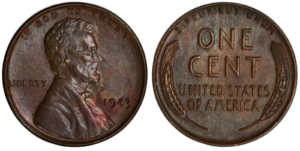
Photo by PCGS
2. A prime example of rare error coins, the 1955 Doubled Die Lincoln Cent showcases prominent doubling.
A remarkable rare coin to look for is the 1955 Doubled Die Lincoln Cent, renowned for the prominent doubling effect on its obverse. During the minting process, four of the coin’s main design elements, i.e. President Lincoln’s profile, the inscriptions “LIBERTY,” “IN GOD WE TRUST,” and the date, were struck onto it twice instead of once.
This error happened due to a misalignment or misregistration of the coin die during the hubbing. As a consequence, the design elements were impressed onto the coin’s surface slightly offset from their intended position, causing a prominent doubling effect that is easily visible to the naked eye, distinguishing it from regular strikes.
Despite efforts to correct the error, a significant number of these doubled die cents entered circulation, making them highly desirable among collectors for their unique appearance.
1955 1 Cent Doubled Die Obverse
- Metal: Copper
- Year: 1955
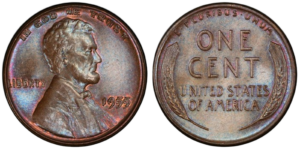
Photo by PCGS
3. The 1982 No Mint Mark Roosevelt Dime ranks among rare US coin errors thanks to its notable absence of a mint mark.
Another one of the most intriguing rare US error coins is the 1982 No Mint Mark Roosevelt Dime. Typically, US coins bear a mint mark indicating where they were produced, such as “P” for Philadelphia or “D” for Denver. Mint marks are punched onto the coin die before striking, but in the case of this 1982 Roosevelt Dime, the mint mark was either omitted or the die used lacked the mint mark altogether.
Although the absence of a mint mark on the 1982 dime was unintentional and likely occurred due to a technical error during the minting process, the error’s exact cause remains uncertain. Some numismatists speculate that the absence of a mint mark on some 1982 Roosevelt Dimes could be attributed to the fact that 1982 was a transitional period for US coinage, where the US Mint transitioned from striking coins with a composition of 90% silver to a copper-nickel clad composition.
1982 10 Cents No Mintmark
- Metal: 75% Copper, 25% Nickel
- Year: 1982
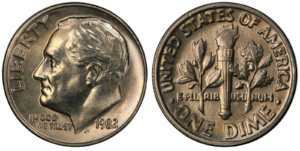
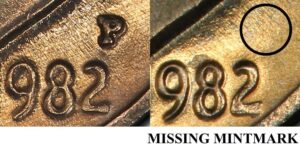
Photos by PCGS
4. A prized find among rare US error coins, the 1983-P Washington Quarter is notable for its cud die breaks.
An extraordinary error coin, the 1983-P Washington Quarter with obverse and reverse cud die breaks, is a fantastic addition to any numismatic collection. This coin exhibits distinctive die breaks, or “cuds”, on both its obverse and reverse faces, setting it apart as a remarkable specimen.
The prominent cuds, characterized by raised areas or blob-like features near the edges of the coin, are a testament to the anomalies encountered during the minting process. These remarkable die breaks are believed to have resulted from damage or deterioration to the coin dies.
Beyond its high rare error coins value, this 1983-P Washington Quarter serves as a tangible reminder of the intricacies involved in minting coins, perpetually capturing the imagination of coin enthusiasts.
1983-P Washington Quarter with Obverse and Reverse Cud Die Breaks
- Metal: 75% Copper, 25% Nickel
- Year: 1983
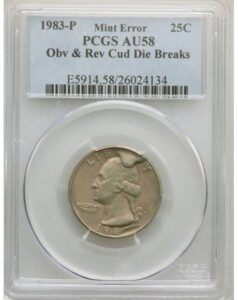
5. A standout among rare mint error coins, the 2000-P Sacagawea Cheerios Dollar showcases a distinct tail feather design error.
The 2000-P Sacagawea Cheerios Dollar is a highly sought-after and valuable error coin that originated from a unique promotional campaign by General Mills. During the launch of the Sacagawea dollar coin, the American multinational food company General Mills distributed a small number of these coins encased in plastic capsules as part of a marketing promotion with boxes of Cheerios cereal.
These coins, often referred to as “Cheerios Dollars,” were minted using a unique method distinct from regular Sacagawea dollars. This resulted in a tail feather design error, noticeably different from the smoother, less defined tail feather pattern found on standard Sacagawea dollars.
Due to their limited distribution and distinct design, these error coins are considered rare and highly collectible among numismatists, representing a unique find for those seeking rare no date Sacagawea coins with errors and more.
2000-P Sacagawea Cheerios Dollar
- Metal: Copper
- Year: 2000
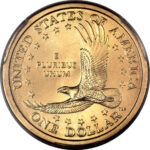
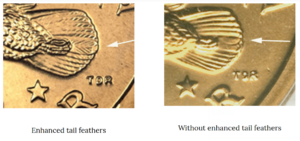
Browse through Blanchard’s extensive selection of rare US error coins here.
Rare mint error coins from all over the world
Shifting our focus to error coins beyond the borders of the United States, these international rarities offer a fascinating glimpse into the intricacies of coin production and the diversity of errors found in global currency.
1. One of the UK’s most coveted rare error coins, the 1983 ‘New Pence’ 2p coin is renowned for its misprinted inscription.
The 1983 ‘New Pence’ 2p coin is one of the most remarkable rare mint error coins in British numismatics. Amidst a transitional period in British coinage during 1982, the Royal Mint was in the process of updating the inscription on the 2p coin from “New Pence” to “Two Pence.” However, a peculiar occurrence arose when a fraction of the 1983-dated 2p coins were inadvertently struck with the outdated “New Pence” inscription instead.
The presence of the incorrect inscription renders the 1983 ‘New Pence’ 2p coin a rare and sought-after piece among collectors, highlighting the evolving nature of British currency during that time.
1983 New Pence 2p
- Metal: Bronze
- Year: 1983
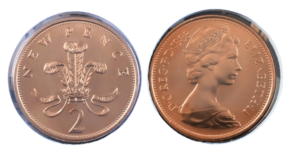
Photo by The Britannia Coin Company
2. With its unusually large date, Canada’s 1969 10 Cents is a standout among rare mint error coins.
The 1969 Canadian 10 Cents coin stands out among Canadian numismatic treasures due to a unique error. Unlike standard issues, some coins from this year feature noticeably larger date digits.
This error likely occurred due to a misalignment or the use of a different die during the minting process. Notably, fewer than 20 examples of this coin exist, making it an exceptionally valuable find for collectors of Canadian rare error coins.
Elizabeth II 10 Cents 1969 Large Date
- Metal: Nickel
- Year: 1969
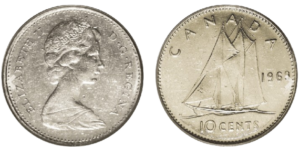
3. Featuring a distinctive curved clip, the 1981 Curved Clip 10 Cent is a special find among rare error coins.
A significant example of a rare Australian 10 Cent coin error is the 1981 Curved Clip 10 Cent, which features a pronounced curve along the edge, distinguishing it from standard issue of the coin. This anomaly happened when a portion of the coin’s metal strip was inadvertently clipped during minting, resulting in a distinctive curved shape along one edge of the coin. This clipping error is typically caused by the minting equipment improperly feeding the coin strip into the press.
Despite its small size, a curved clip significantly affects the appearance and value of the coin, and collectors eagerly seek out such error coins for their uniqueness, making the 1981 Curved Clip 10 Cent coin highly sought-after.
1981 Ten Cent Curved Clipped Planchet Error
- Metal: Copper Nickel
- Year: 1981
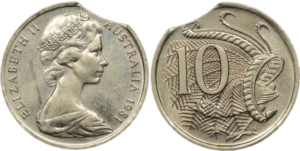
Photo by The Purple Penny
4. One of Australia’s most coveted rare mint error coins, the 2010 Upset Error 50 Cent demonstrates significant striking misalignment.
When it comes to rare australian 50 cent coin errors, the Australian 2010 Upset Error 50 Cent coin exhibits a fascinating anomaly in its design. During its minting process, a 30 degree misalignment of the obverse and reverse dies caused the coin’s design elements to be off-center or tilted. As a result, they appear tilted or askew in relation to the coin’s edge. Collectors are particularly drawn to this unique error for its unconventional and visually striking features.
2010 50 Cent Upset Error
- Metal: Cupro-Nickel
- Year: 2010
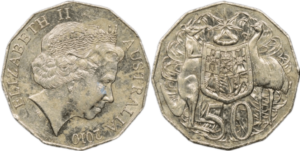
Photo by The Purple Penny
Learn more about Australian rare coins here.
5. A unique example of rare coin errors, the 1907 10 Centavos from Mexico features a lamination anomaly.
As one of the most important rare error coins in circulation that the Mexican government is in the process of withdrawing, this 1907 10 Centavos coin is considered a special stand in numismatic circles due to an unusual error. Struck on a laminated planchet, this error is visibly apparent on the coin’s obverse. The lamination process, involving layers of metal bonded together, resulted in a distinct appearance that differs from standard coins of the series, adding to the coin’s appeal.
1907 10 Centavos Lamination Error
- Metal: Silver
- Year: 1907
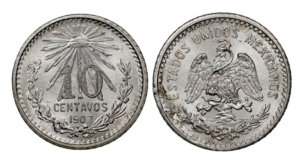
Photo by NGC Collectors Society
Where to buy rare coins
Error coins, both from the United States and around the world, hold a captivating allure for collectors and enthusiasts alike. From intriguing misprints to die breaks and incorrect planchet composition, each error coin tells a story of its own, showcasing the fascinating complexities of minting processes and the rich history of numismatics.
To enhance your coin collection with rare coins, Blanchard‘s unparalleled offerings are the perfect choice. Consulting Blanchard’s team of experts for further guidance and insights into rare error coins value and more.
Want to read more? Subscribe to the Blanchard Newsletter and get our tales from the vault, our favorite stories from around the world and the latest tangible assets news delivered to your inbox weekly.







